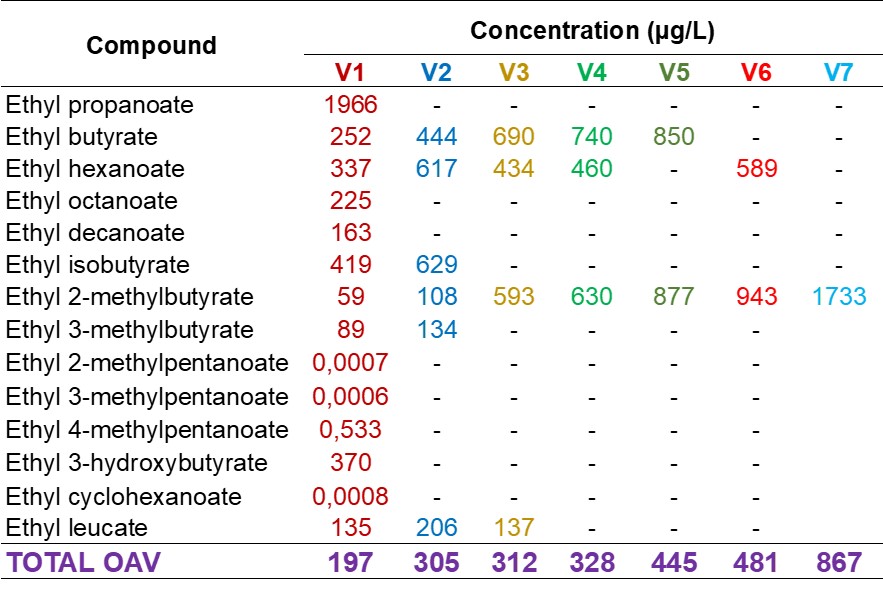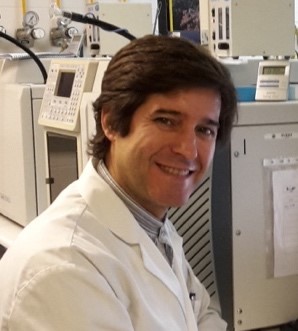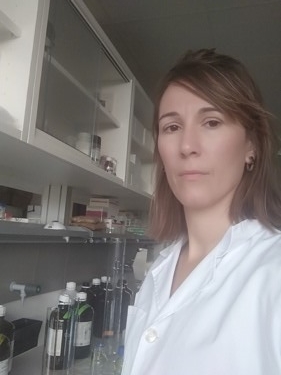By Vicente Ferreira
Food Chem., 307, 2020: 12553
https://doi.org/10.1016/j.foodchem.2019.125553
Wine aroma has been always considered to be undecipherable. This paper begins to question such idea.
One of the major reasons for the belief in undecipherability is the high number of different odorants present in wine and the complex perceptual interactions they can play leading to the final palette of wine odors. Supporters for undecipherability mention results showing that, even odorants present at subthreshold levels, or even small differences in the distribution of natural enantiomers*, have dramatic effects on the qualitative characteristics of the mixture. However, some of those results were obtained studying the effects of the minor odorants on the odor thresholds of the mixtures and, at threshold levels, there are strong interaction effects that are not effective at normal levels of concentration.
What this paper demonstrates is that the 14 different ethyl esters naturally found in wines, all of them displaying similar, but slightly different aroma nuances, can be replaced just by 3 or even 1 of the ethyl esters, without noticing any qualitative change. In a neutral wine model without any salient odor, the 3 most intense in the original wine are required (ethyl butyrate, ethyl hexanoate and ethyl 2-methylbutyrate). In a wine model displaying oaky odor, just 1 of the most intense suffices (ethyl 2-methyl butyrate or ethyl 3-methylbutyrate). We did not work with different enantiomeric distributions, but some of the odorants considered in the study have enantiomers with slightly different odor characteristics. If the odorant can be directly replaced by a different compound (for instance, ethyl 2-methylbutyrate can be replaced by ethyl 3-methylbutyrate), we should not expect large differences from little differences in the ratios of the two specific enantiomers of ethyl 2-methylbutyrate.
The main conclusion of this finding is that many slightly different aroma compounds displaying relatively similar odors, act together in a concerted and integrated way, so that, individual odorants add nearly nothing in qualitative terms. This has a clear logic: in a complex odor environment, our brain pays little attention to small irrelevant differences and concentrates in the big picture to find some meaning. Similar odors are then set together constituting an “aroma vector” which will interact with some other “aroma vectors” present to produce the final outcome: all the odors noted in wine. The system is yet very complex, but the finding suggests that the complexity is not out of reach and that wine aroma can be deciphered by identifying the limited number of active aroma vectors that it contains.

Not anecdotally, the reduction in odor diversity has to be compensated by a strong increase in concentration to keep odor intensity. This is seen in the number of odor activity value (OAVs) present in the different isointense ester mixtures prepared in the work. Odor Activity Values are just concentrations normalized by odor thresholds. These data are summarized in the following table which gives the composition of the 7 different mixtures of esters. The last row gives the summation of the OAVs of all the odorants present in the mixture. As can be seen the original mixture (V1) containing the 14 esters contained an accumulated OAV of just 197. But the following mixture (V2) in which odorants present at subthreshold levels were excluded, required a strong increase reaching OAV=305 to keep isointensity. The OAV of the final mixture containing just 1 odorant (V7), exceed by a factor close to 5 that of the original mixture.

I.e., these results strongly supports the role that many odorants present at close to threshold or even subthreshold levels play, on odor intensity (but not on odor quality). This represents quite a challenge for aroma modeling, because we do have to pay attention not only to the most concentrated odorants, but also to those others at smaller levels, but at least it seems that we have to worry only about intensity and not quality.
The other way around, this result is stimulating for the flavor industry. It suggests that all simple fragrance materials could be advantageously replaced by much smaller levels of complex mixtures.
*two enantiomers are molecules which are specular images, such as our right/left hands; some of them can have different aroma nuances.

Vicente Ferreira
Mail: vferre@unizar.es
Webpage: http://laae.unizar.es/
Scopus id. 7102726672
Researcher ID D-4277-2014
Orcid Code 0000-0002-4353-2483
Full Professor of Analytical Chemistry at the University of Zaragoza and head of the Laboratory for Aroma Analysis and Enology (LAAE). Specialist in the chemical analysis of the molecules responsible for the different perceptions related to the odor, flavor and taste, and in the integration of the chemical information to interpret the sensory perception. This knowledge has been primary applied to wine flavor, a field in which LAAE is world leader. He has authored more than 210 regular scientific papers, some of them of very high impact (h=51 WoS; =51 Scopus, =60 Google Scholar), 12 book chapters, edited 1 book and written numerous scientific divulgation papers. He has supervised 27 PhD Thesis and holds two patents as inventor.

María Pilar Sáenz-Navajas
Mail: Maria@saenz.info
Scopus Author ID: 12808586100
Researcher ID L-6896-2014
Orcid code https://orcid.org/0000-0001-7225-2272
Postdoctoral researcher at Laboratorio de análisis del Aroma y enología. My main research line is to understand the key drivers of wine appreciation, by applying methodologies from consumer and sensory sciences and flavour chemistry. I am focused on the development of conceptual, instrumental and methodological tools for the modeling of sensory properties, mainly tactile sensations, from their content in sensoactive molecules and determine their role in wine appreciation.

Arancha de la Fuente Blanco
Mail: arandlfb@unizar.es
Scopus Author ID: 57189005987 Researcher ID R-9520-2017
Orcid code https://orcid.org/0000-0002-4093-900X
Arancha de la Fuente Blanco has got her PhD in Chemistry in 2019 in the University of Zaragoza. She is interested in the identification of odorants and in modeling odor perception. She is actually working for LAAE in different research projects related to flavor chemistry. She has coauthored 8 scientific JCR articles and 1 book chapter (Elsevier). h-index=4/6 (scopus/GoogleScholar), 55/85 citations (Scopus/GoogleScholar). 19 contributions in scientific symposiums, 2 technical papers.

